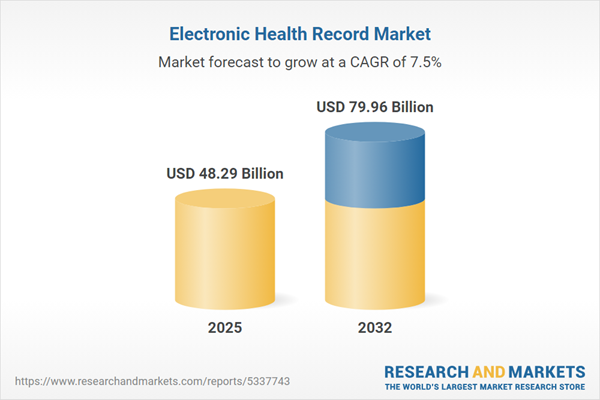Speak directly to the analyst to clarify any post sales queries you may have.
The electronic health record market continues to evolve rapidly, as healthcare organizations seek secure, integrated digital systems to streamline workflows, improve care quality, and support population health objectives. Senior decision-makers face complex choices regarding technology adoption, compliance, and deployment models in this dynamic landscape.
Market Snapshot: Electronic Health Record Market Growth at a Glance
The electronic health record market grew from USD 44.96 billion in 2024 to USD 48.29 billion in 2025. Forecasts project ongoing expansion at a CAGR of 7.46%, with the market set to reach USD 79.96 billion by 2032. This trajectory reflects the sector’s response to shifting care delivery models, regulatory demands, and a growing imperative for digital transformation.
Scope & Segmentation: Comprehensive EHR Market Coverage
- Component: Software platforms; Services including consulting, implementation, and training/support
- Product Type: Integrated EHR; Standalone EHR
- Functionality: Analytics and reporting, clinical decision support, clinical documentation, computerized physician order entry, e-prescribing, interoperability and health information exchange, patient portal and engagement, revenue cycle management, telemedicine
- Licensing: Pay-per-use; Subscription
- Application: Cardiology, gastroenterology, general medicine, mental and behavioral health, nephrology and urology, neurology, oncology, ophthalmology, pediatrics, physical therapy and rehabilitation, radiology
- End User: Ambulatory care centers, clinics and physician offices, hospitals, long-term care facilities
- Deployment Mode: Cloud; On-premise
- Geographic Coverage: Americas (North America, Latin America), Europe, Middle East, Africa, Asia-Pacific, with specific analysis by country such as United States, Canada, Brazil, United Kingdom, Germany, Japan, China, and more
- Company Landscape: AdvancedMD, Allscripts Healthcare, Athenahealth, Azalea Health Innovations, CareCloud, Computer Programs and Systems, CureMD.com, DrChrono, eClinicalWorks, Epic Systems, GE HealthCare Technologies, Greenway Health, Medical Information Technology, Modernizing Medicine, NextGen Healthcare, Oracle, among others
Key Takeaways for Decision-Makers
- Advancements in interoperability and cloud deployments are redefining how providers access and utilize patient data, supporting greater clinical efficiency and organizational flexibility.
- Healthcare organizations increasingly prioritize platforms with robust analytics and AI-powered decision support to enhance clinical and operational outcomes.
- Evolving regulatory frameworks drive vendors to incorporate open APIs, ensuring better health information exchange and compliance in a multi-stakeholder environment.
- Patient engagement functionalities, such as portals and telehealth integration, now command central importance and are influencing purchasing decisions at every level of care.
- The choice between subscription and pay-per-use licensing models empowers institutions to optimize capital allocation and system utilization based on operational scale.
Tariff Impact: Market Dynamics and Procurement Strategies
Recent tariff proposals affecting imported medical device components and software may disrupt cost structures for vendors and healthcare buyers. Hardware sourced internationally—such as servers and tablets—faces potential cost increases, driving some organizations to adopt cloud-based solutions to minimize hardware dependencies. Stakeholders are proactively revising supply chain strategies and negotiating new terms to manage potential risk and mitigate disruption to digital health initiatives.
Methodology & Data Sources
This report utilizes a mixed-method approach, integrating extensive secondary research, primary interviews with industry experts, and data triangulation. The methodology ensures clarity and accuracy by validating market trends, adoption challenges, and technology advancements against both published data and direct stakeholder input.
Why This Report Matters
- Enables leaders to benchmark technology investments and vendor choices in a complicated regulatory environment.
- Supports strategic planning by delivering actionable segmentation and regional insights tailored for effective EHR implementation.
- Equips executive teams with fact-checked analysis and forward-looking industry trends to guide market entry and operational transformation.
Conclusion
The electronic health record market is transitioning from basic digital administration to driving meaningful value in clinical and operational performance. By leveraging this report’s findings, organizations can optimize decision-making and stay prepared for evolving healthcare and regulatory demands.
Additional Product Information:
- Purchase of this report includes 1 year online access with quarterly updates.
- This report can be updated on request. Please contact our Customer Experience team using the Ask a Question widget on our website.
Table of Contents
3. Executive Summary
4. Market Overview
7. Cumulative Impact of Artificial Intelligence 2025
Companies Mentioned
The companies profiled in this Electronic Health Record market report include:- AdvancedMD, Inc.
- Allscripts Healthcare, LLC
- Amazing Charts, LLC
- Athenahealth, Inc.
- Azalea Health Innovations, Inc.
- CareCloud, Inc.
- Computer Programs and Systems, Inc.
- CureMD.com Corp.
- DrChrono Inc.
- eClinicalWorks, LLC
- Epic Systems Corporation
- GE HealthCare Technologies Inc.
- Greenway Health, LLC
- Medical Information Technology, Inc.
- Modernizing Medicine, Inc.
- NextGen Healthcare, Inc.
- Oracle Corporation
- Tebra Technologies, Inc.
- TherapyNotes, LLC
- Waiting Room Solutions, LLC
Table Information
| Report Attribute | Details |
|---|---|
| No. of Pages | 188 |
| Published | November 2025 |
| Forecast Period | 2025 - 2032 |
| Estimated Market Value ( USD | $ 48.29 Billion |
| Forecasted Market Value ( USD | $ 79.96 Billion |
| Compound Annual Growth Rate | 7.4% |
| Regions Covered | Global |
| No. of Companies Mentioned | 21 |









